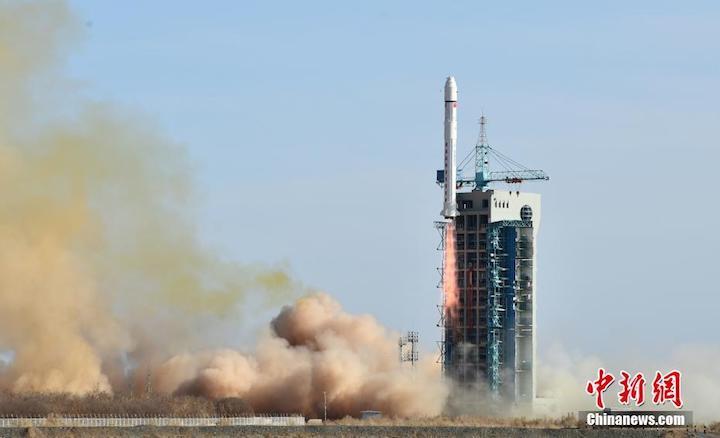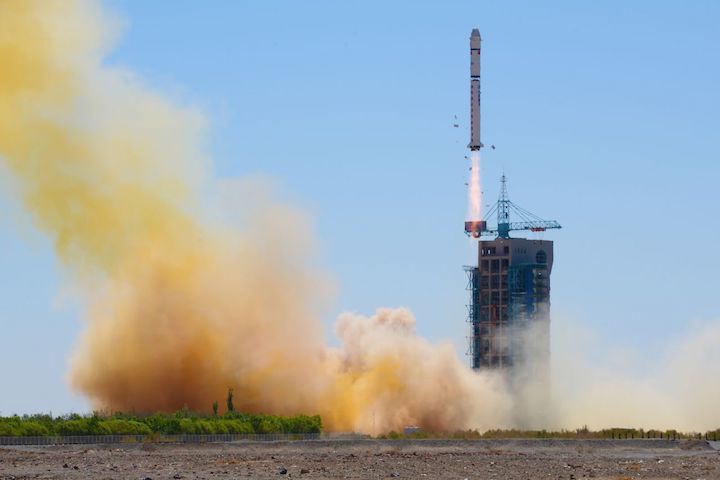China is set to launch an experimental seismo-electromagnetic probe on Friday from the Jiuquan launch centre, with small ESA and commercial satellites along for the ride.
A Long March 2D rocket will carry the main and piggybacking payloads into low Earth orbit from Jiuquan in the Gobi Desert, with launch anticipated to be around 15:50 local time (07:50 UTC).
The launch will be China's sixth following a busy January, with the country planning a possible 40 launches for 2018.
The main payload is Zhangheng-1, also known as the China Seismo-Electromagnetic Satellite (CSES). CSES is a collaborative project between the China National Space Administration (CNSA) and Italian Space Agency (ASI), and includes a range of Chinese and Italian universities and research institutions to monitor electromagnetic and atmospheric phenomena, and study correlations with the occurrence of seismic events.
Zhangheng-1
Zhangheng-1, named after the Chinese polymath, astronomer and pioneering seismologist Zhang Heng (CE 78–139), is designed to remain in orbit for five years and record the electromagnetic situation of earthquakes above 6 magnitude in China and quakes above 7 magnitude all over the world.
Also referred to as the China-Italy Electromagnetic Monitoring Experiment Satellite Program, the satellite will aim to provide insight into the lithosphere-atmosphere-ionosphere coupling, analysing temporal correlation between seismic events and occurrence of electromagnetic perturbations in the upper ionosphere.
It will carry a range of instruments to detect and measure high-energy particles, plasma, and electric and magnetic fields. Data collected by the mission will also allow for studying solar-terrestrial interactions and phenomena including Coronal Mass Ejections and solar flares.

A rendering of the Zhangheng-1 satellite (CSES).
The 730 kg Zhangheng-1 satellite is based on the CAST2000 platform developed by the China Academy of Space Technology (CAST), and will be placed in a 98° Sun-synchronous circular orbit at an altitude of around 500 km.
GomX-4A and 4B
Two near-identical cereal box-sized satellites - ESA's latest technology-testing CubeSat GomX-4B and Danish GomX-4A - will be along for the ride to test intersatellite communication links and propulsion while in orbit.
Once in orbit, ESA's GomX-4B will use new cold-gas propulsion to separate from GomX-4A, developed by GomSpace, to a distance of around 4,500 km, using highly miniaturised thrusters contributed by Sweden’s NanoSpace company, according to an ESA press release.
"The two CubeSats will test intersatellite link technology, routing data from one satellite to the other, then down to the ground station," says Roger Walker, head of ESA's Technology CubeSat initiative.

A rendering of the GomX-4A and GomX-4B CubeSats.
New Satellogic Aleph-1 sats
Friday's launch will also carry the fourth and fifth satellites for Satellogic, a commercial space company based in Argentina, which is aiming to establish its Aleph-1 constellation, which will consist of up to 25 satellites, to provide commercial Earth observation services.
ÑuSat-4 and ÑuSat-5 are named Ada and Maryam, for the English mathematician and writer Ada Lovelace, famed for her early contributions to computing, and Maryam Mirzakhani, the recently deceased Iranian mathematician.
Satellogic aims to have as many as 300 satellites in orbit within the next few years. The company put its previous satellites on Long March launches, describing the launch vehicles as very reliable, and with a launch cost of between US$1-2m per satellite.
Teen satellite
China's Teen Satellite Project has produced a 2-Unit CubeSat known as Shaonian Xing (少年星), and roughly translating to 'Junior Sat' or 'Youth Sat'.
The initiative is an outreach project designed to engage youth in thinking about space, STEAM education, and even satellite development. Launched in April 2016, it garnered more than 100,000 ideas from students at over 1,000 primary and secondary schools across the country.
A number of teenagers were then selected from the applications received and invited to design and develop the satellite along with space scientists.

A rendering of the Shaonian Xing, or 'Youth Sat', a 2U CubeSat.
Satellite for reusable rocket company
Fengmaniu-1, a 3U CubeSat with deployable solar panels designed to test new optical components in space, is also reported to be along for the ride. Its developer is Link Space Aerospace Technology Inc, or Link Space, a private Chinese rocket company looking to follow the launch vehicle reusability trail blazed by SpaceX.
China launches seismo-electromagnetic probe along with ESA, Danish and commercial CubeSats

The Long March 2D rocket carrying Zhangheng-1 (CSES), GomX-4A and 4B, FMN-1, Ada and Maryam, and Pioneer Satellite 1 lifts off from Jiuquan at 15:51 local time (07:51 UTC) on February 2, 2018. CNS
-
China launched a seismo-electromagnetic probe on Friday, along with CubeSats for the European Space Agency, Denmark, companies Satellogic and Linkspace, and a youth space project.
The cluster of satellites were launched on a Long March 2D rocket from the Jiuquan Satellite Launch Centre in the Gobi Desert at 15:51 local time (07:51 UTC).
The two-stage hypergolic launch vehicle sent the seven satellites towards a 500 km altitude Sun-synchronous orbit, with Chinese aerospace institutes confirming success within an hour.
The launch was China's sixth for 2018, with the country planning around 40 launches for the year, including government and commercial missions. Today's mission was due to lift off in August 2017, but was delayed, at least initially, by two launch issues suffered in June and July.
China-Italy Electromagnetic Monitoring Experiment Satellite
The main launch payload is Zhangheng-1, also known as the China Seismo-Electromagnetic Satellite (CSES). CSES is a collaborative project between the China National Space Administration (CNSA) and Italian Space Agency (ASI), and includes a range of Chinese and Italian universities and research institutions to monitor electromagnetic and atmospheric phenomena, and study correlations with the occurrence of seismic events.
Zhangheng-1, named after the Chinese polymath, astronomer and pioneering seismologist Zhang Heng (CE 78–139), is designed to remain in orbit for five years and record the electromagnetic situation of earthquakes above 6 magnitude in China and quakes above 7 magnitude all over the world.
Quelle: gbtimes
+++
China launches first shared education satellite
China's first shared education satellite, Young Pioneer 1, carried by the Long March-2D rocket, was launched into space from Jiuquan Satellite Launch Center Friday afternoon.
The 3-kg CubeSat (100 * 100 * 340mm), Young Pioneer 1, enters an orbit of 502 km above the Earth. The rocket also carried Zhangheng 1, an electromagnetic satellite to study earthquake data, and five other miniaturized satellites.
Young Pioneer 1 was manufactured and tested by Commsat, a Beijing-based private satellite company funded by the Xi'an Institute of Optics and Precision Mechanics under the Chinese Academy of Sciences (CAS).
It will perform wireless storage and transmission of radio waves at UV frequency, space imaging and the verification of user links to the Internet of Things, said Xie Tao, founder and CEO of Commsat.
After in-orbit tests, Young Pioneer 1 will share its data resources with primary and secondary schools and other education institutions equipped with sub-stations in China. It will provide students with experiences like wireless communication and space photography, Xie said.
"Since our company is based in an industrial park for start-ups, Young Pioneer 1 could also be seen as China's first satellite made in a warehouse," Xie said.
After working for the state-run China Aerospace Science and Technology Corporation for more than a decade, Xie resigned in 2014 and set up his own company in June 2015.
The shift from state-run companies to entrepreneurial warehouse indicates the increasing diversity and opportunities in China's aerospace industry.
Xie believes his company, a pioneer of commercial satellites, is more market-oriented, closer to the public and "down to earth."
"We have equipped Young Pioneer 1 with an intelligent CPU chip that will enable the satellite to restart if problems occur, just like a smart phone. In the future, the chips will be upgraded very quickly, which will help us make more intelligent nanosatellites with more functions," he said.
"To cut costs, commercial satellites also use cheaper components and parts, unlike state space missions, which are usually of strategic importance and must have no mistakes," he added.
Quelle: Xinhua
+++
China launches electromagnetic satellite to study earthquake precursors
China on Friday launched its first seismo-electromagnetic satellite to study seismic precursors, which might help establish a ground-space earthquake monitoring and forecasting network in the future.
A Long March-2D rocket launched at 15:51 from Jiuquan Satellite Launch Center, in northwest China's Gobi Desert, carried the 730-kilogram China Seismo-Electromagnetic Satellite (CSES) into a sun-synchronous orbit at an altitude of about 500 kilometers.
Known as Zhangheng 1 in Chinese, it will help scientists monitor the electromagnetic field, ionospheric plasma and high-energy particles for an expected mission life of five years, said Zhao Jian, a senior official with China National Space Administration (CNSA).
The satellite is named after Zhang Heng, a renowned scholar of the East Han Dynasty (25-220), who pioneered earthquake studies by inventing the first ever seismoscope in the year 132.
Zhangheng 1 will record electromagnetic data associated with earthquakes above 6 magnitude in China and those above 7 magnitude around the world, in a bid to identify patterns in the electromagnetic disturbances in the near-Earth environment, Zhao said.
Covering the latitude area between 65 degrees north and 65 degrees south, it will focus on Chinese mainland, areas within 1,000 kilometers to China's land borders and two major global earthquake belts.
Zhangheng 1 was funded by CNSA, developed by China Earthquake Administration (CEA) and produced by DFH Satellite Co., Ltd., a subsidiary of China Academy of Space Technology (CAST).
Based on a CAST2000 platform, Zhangheng 1 is a cubic satellite, 1.4 meters on each side. It has a single solar panel and six booms, which will deploy and keep electromagnetic detectors more than 4 meters away from the satellite, said Zhou Feng, a senior manager with DFH Satellite Company.
It carries a high-precision magnetometer, a search-coil magnetometer and electric field probes to measure components and intensity of the magnetic and electric fields. It is also equipped with a Langmuir probe, a plasma analyzer, a GNSS occultation receiver and a tri-band beacon to measure in-situ plasma and ionospheric profile as well, Zhou said.
It also carries high-energy particle detectors, some of which are provided by Italian partners, and a magnetic field calibration device developed in Austria, according to Zhou.
DETECTING EARTHQUAKE PRECURSORS
China is one of the countries most affected by dynamic earthquakes, which are often widespread over terrain, high in magnitude and shallow in the epicenter.
However, scientists around the world are still unable to predict earthquakes despite efforts by various countries since the 1950s.
In recent years, more efforts have focused on monitoring seismo-electromagnetic anomalies in the near-Earth environment.
Research shows that just before a quake, tectonic forces acting on the Earth's crust emit electromagnetic waves and twist magnetic field lines. But such electromagnetic phenomena are relatively weak and need further study to be useful.
Zhangheng 1 will help scientists better understand the coupling mechanisms of the upper atmosphere, ionosphere and magnetosphere and the temporal variations of the geomagnetic field, and thus accumulate data for the research of seismic precursors, Zhao said.
"Zhangheng 1 cannot be used to predict earthquakes directly, but it will help prepare the research and technologies for a ground-space earthquake monitoring and forecasting system in the future," he noted.
Shen Xuhui, deputy chief designer of Zhangheng 1, said it will gather enough data to build models of the Earth's geomagnetic field and ionosphere, which are still unknown to China.
"Zhangheng 1, with a wider coverage and better electromagnetic environment from space, will be an important supplement to earthquake monitoring in Qinghai-Tibet Plateau and sea areas that cannot be fully covered by the ground observation network," said Shen, also chief engineer of the Institute of Crustal Dynamics of the CEA.
It will have access to more earthquake data, which will help identify patterns in pre-quake changes in the ionosphere via statistical analysis, Shen added. Enditem
Quelle: Xinhua

